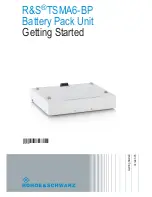
4
5
CAT.
1. Contacts
2. Release buttons
3. Fuel Gauge button
4. Fuel Gauge
5. Electrical contacts
6. Bay
7. Serial Number (on bottom of charger)
8. Vents
9. Light indicators - when a battery pack is inserted
into the charger, the light will indicate the following:
Continuous red: Charging
Continuous green light: Charging is complete
Flashing red: Battery is too hot/cold - Charging will
begin when battery reaches correct
charging
temperature
Flashing red/green: Damaged or faulty battery pack
FUNCTIONAL DESCRIPTION
2
4
1
7
9
8
2
SYMBOLOGY
Volts
Direct Current
Alternating Current
Double Insulated
Properly Recycle Batteries
Hertz
Amps
Underwriters Laboratories, Inc.
United States and Canada
* Charges
MILWAUKEE
48-11-1815, 48-11-1820, 48-11-1828 and
48-11-1840 Li-Ion battery packs.
SPECIFICATIONS
Charger*
Cat. No.
48-59-1801
2710-20
AC Input
Volts
120
120
AC Input
Amps
2.1
2.1
DC Output
Volts
18 DC
18 DC
DC Output
Amps
3.1
3.1
DC Input
Volts
- -
12
DC Input
Amps
- -
6.5
Li-Ion Battery
Cat. No.
48-11-1815
48-11-1820
48-11-1828
48-11-1840
DC
Volts
18
18
18
18
Charge
Time
30-Min
30-Min
1-Hour
1-Hour
5
6
3
READ AND SAVE ALL INSTRUCTIONS
READ AND SAVE ALL INSTRUCTIONS
FOR FUTURE REFERENCE.
FOR FUTURE REFERENCE.
Fuel Gauge
Use the Fuel Gauge to determine the battery pack's
remaining run time. Press the Fuel Gauge button to
display the lights. The Fuel Gauge will light up for
2-3 seconds. When less than 10% of charge is left,
1 light on the fuel gauge will fl ash slowly.
MILWAUKEE LITHIUM-ION BATTERY PACK OPERATION
78-100
%
55-77
%
33-54
%
10-32
%
Less than 10% if bottom light is fl ashing
Approximate Run
Time Remaining
NOTE:
If the Fuel Gauge doesn't appear to be
working, place the battery pack on the charger and
charge as needed.
Compared to NiCd battery pack types,
MILWAUKEE
Lithium-Ion battery packs deliver fade-free power
for their entire run time. The tool will not experience
a slow, gradual loss of power as you work. To signal
the end of discharge, 1 light on the fuel gauge will
fl ash quickly for 2-3 seconds and the tool will not
run. Charge the battery pack.
NOTE:
Immediately after using the battery pack,
the Fuel Gauge may display a lower charge than it
will if checked a few minutes later. The battery cells
"recover" some of their charge after resting.
Battery Pack Protection
To protect itself from damage and extend its life, the
battery pack’s intelligent circuit monitors current draw
and temperature. In extremely high torque, binding,
stalling, and short circuit situations, the battery pack
will turn OFF the tool if the current draw becomes
too high. All the fuel gauge lights will fl ash. Release
the trigger and restart.
Under extreme circumstances, the internal tem-
perature of the battery could become too high. If
this happens, the fuel gauge lights will fl ash in an
alternating pattern and the tool will not run. Allow
the battery to cool down.
Disposing of MILWAUKEE Li-Ion Battery Packs
MILWAUKEE
Lithium-Ion battery packs are more
environmentally friendly than some other types of
power tool battery packs (e.g., nickel-cadmium).
Always dispose of your battery pack according to
federal, state and local regulations. Contact a recy-
cling agency in your area for recycling locations.
Even discharged battery packs contain some en-
ergy. Before disposing, use electrical tape to cover
the terminals to prevent the battery pack from short-
ing, which could cause a fi re or explosion.
RBRC Battery Recycling Seals
The RBRC™ Battery Recycling Seals (see "Sym-
bology") on your tool battery packs indicate that
MILWAUKEE
has arranged for the recycling of
that battery pack with the Rechargeable Battery
Recycling Corporation (RBRC). At the end of your
battery pack's useful life, return the battery pack to
a
MILWAUKEE
Branch Offi ce/Service Center or the
participating retailer nearest you. For more informa-
tion, visit the RBRC web site at www.rbrc.org.
Cold Weather Operation
MILWAUKEE
Lithium-Ion battery packs are de-
signed to operate in temperatures below freezing.
When the battery pack is too cold, it may need to
warm up before normal use. Put the battery on a
tool and use the tool in a light application. It may
“buzz” for a short time until it warms up. When the
buzzing stops, use the tool normally.
Maintenance and Storage
Do not expose your battery pack or cordless tools
to water or rain, or allow them to get wet. This could
damage the tool and battery pack. Do not use oil
or solvents to clean or lubricate your battery pack.
The plastic casing will become brittle and crack,
causing a risk of injury.
Store battery packs at room temperature away
from moisture. Do not store in damp locations
where corrosion of terminals may occur. As with
other battery pack types, permanent capacity
loss can result if the pack is stored for long pe-
riods of time at high temperatures (over 120° F).
MILWAUKEE
Lithium-Ion battery packs maintain
their charge during storage longer than other
battery pack types. After about a year of storage,
charge the pack as normal.
WARNING
To reduce the risk of injury
or explosion, never burn or inciner-
ate a battery pack even if it is damaged, dead
or completely discharged. When burned, toxic
fumes and materials are created.
Fuel Gauge Lights Diagnosis
Solution
Lights 1 - 4 Solid
Remaining run
time
Continue working
1 Light, fl ashing
slowly
Less than 10%
run time left
Prepare to charge pack
1 Light, fl ashing
quickly
End of discharge
Charge pack
Lights 1-4, fl ashing
quickly
Current draw too
high
Release trigger and
restart, reduce pressure
Lights 1&3 /
2&4, fl ashing
alternatingly
Battery
temperature too
high
Release trigger and
allow battery to cool






















